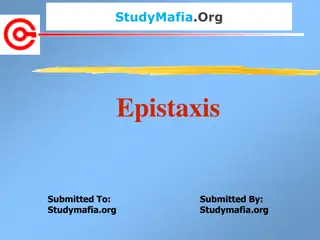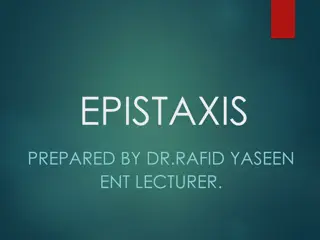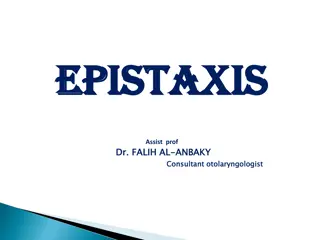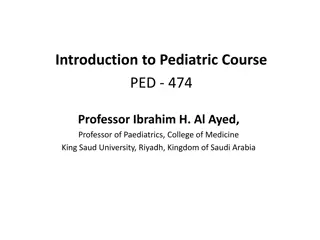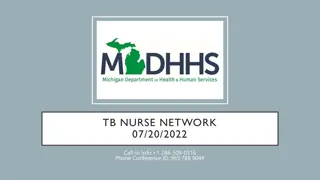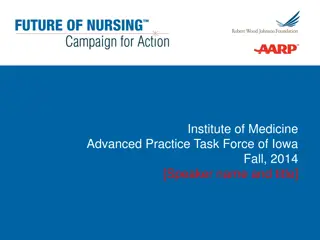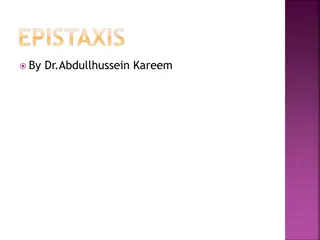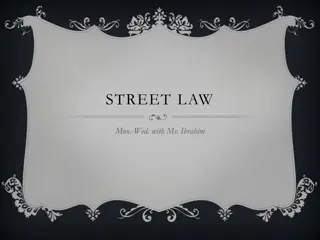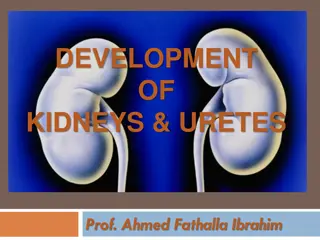Comprehensive Guide to Epistaxis Management by Nurse Aliyu Ibrahim
Bleeding from the nose, known as epistaxis, can stem from various factors and regions within the nasal cavity. Understanding the epidemiology, anatomy, and blood supply of the nose is essential for effective management. This guide delves into the causes, symptoms, classification, diagnostic evaluation, nursing management, and possible complications of epistaxis. By exploring the nuances of this condition, healthcare professionals can enhance their knowledge and skills in providing optimal care to patients experiencing epistaxis.
Download Presentation

Please find below an Image/Link to download the presentation.
The content on the website is provided AS IS for your information and personal use only. It may not be sold, licensed, or shared on other websites without obtaining consent from the author.If you encounter any issues during the download, it is possible that the publisher has removed the file from their server.
You are allowed to download the files provided on this website for personal or commercial use, subject to the condition that they are used lawfully. All files are the property of their respective owners.
The content on the website is provided AS IS for your information and personal use only. It may not be sold, licensed, or shared on other websites without obtaining consent from the author.
E N D
Presentation Transcript
MANAGEMENT OF EPISTAXIS BY NURSE ALIYU IBRAHIM
TABLE OF CONTENT Definition. Epidemiology Anatomy and physiology of the affected organ Blood supply Causes Sign and symptoms classification Types of epistaxis Diagnostic evaluation Management Nursing management Complications Conclusion Refrences
DEFINITION Bleeding from inside the nose is called epistaxis, is a sign and not a disease per se, an attempt should be made to find its any local or constitutional cause. Nose bleed may occur from the anterior portion (kiesselbach s plexus) or posterior part on the nose (woodruff s area), It can be unilateral or bilateral.
EPIDEMIOLOGY Approximately 50% of population experience nosebleed at least once their life but it is serious enough to seek medical consultation in less than 10%, most patients present as an emergency. AGE Children usually have mild anterior nasal bleeding while elderly have profuse posterior nose bleeding. GENDER Males are more affected than the female but after the age of 50years both gender are affected equally. RACE Its more common in Caucasian compaired with Africa-americans. Mohan Bansal (2017)
ANATOMY AND PHYSIOLOGY OF THE AFFECTED ORGAN Nose is the first organ of respiration, its located in the anterior mid of the face, its an osteo-cartilagenous framework covered by muscles, skin and mucus membrane, its divided anterior posteriorly into external nose and nasal cavity proper and medially by nasal septum into right and left nostrils. Breathing Olfaction Humidification Filtration Resonance Reflex action Etc.
BLOOD SUPPLY OF THE NOSE Nose is richly supply by the branches of internal and external carotid systems, both on the septum and on the walls. Internal carotid system a) Anterior ethmoidal artery b) Posterior ethmoidal artery External carotid system a) Facial artery (superior labial artery) b) Maxillary artery (greater & lesser palatine arteries and sphenopalatine artery).
CAUSES The common causes of children are Major trauma Nose picking Rhinitis Foreign body in the nose Nasal injury Nasal polyp Nasal diphtheria Nasopharyngeal tumors Nasal spry abuse Hot summer month
OTHER SYSTEMIC CAUSES:- Leukemia Hemophilia Ingestion of aspirin Vitamin K deficiency Ca deficiency Nephritis Solar radiation Acute infections Thrombocytopenia
SIGN & SYMPTOMS Signs of excessive blood loss include: Dizziness Weakness confusion fainting
CLASSIFICATION OF EPISTAXIS Anterior epistaxis More common Mostly from Little's area or anterior part of lateral wall Mostly occurs in children or young adults Mostly trauma Usually mild, can be easily controlled by local pressure or anterior pack Posterior epistaxis Less common Mostly from posterosuperior part of nasal cavity After 40 years of age Spontaneous; often due to hypertension or arteriosclerosis Bleeding is severe, requires hospitalization; postnasal pack often required
OTHER TYPES OF EPISTAXIS Recurrent Epistaxis:- in recurrent nose bleeds the episode of bloods happens only at certain periods of time. Recurrent nosebleed can be seasonal. Its mostly happens when the weather get hot and dry. Constant Epistaxis:- this is type of nose bleed that happens for a longer period of time. The bleeding is continuouse ( 45min). Sudden epistaxis:- These are nosebleeds which could happen anytime of the day, regardless of the activity of the individual, Whether at rest or while active. Chronic epistaxis:- nosebleed experienced for more then 6month. This type of bleeding happen as result of a chronic disease such as; Chronic liver or kidney disease, vascular malformation,
heavy nosebleed:- where there is a significant amount of blood coming out of the nose or post nasally and through mouth. in this type; immediate first aid treatment must be employed.
DIAGNOSTIC EVALUATION History Blood pressure Complete blood count Coagulation studies Angiography Endoscopy MRI CT scan X ray
GENERAL MANAGEMENT First aid measures:- Place the forward. Apply direct pressure by pinching the entire soft lower portion of the nose for 5min. Apply icepack to the nose and check area. Loosing clothes and giving reassurance. Gently insert a small gauze pad into the bleeding nostril and apply digital pressure if bleeding continues. Take medical treatment if bleeding does not stop. Identification of bleeding sit by a nasal speculum or headlight. patient in a sitting position, leaning
TROTTER'S METHOD Sit and lean forward slightly Pinch nostrils Breathe through mouth
Anterior nasal bleeding:- Anterior pressure packing Use of an inflatible tampon Silver nitrate application Electrocautery Posterior nasal bleeding:- Posterior nasal packing with Cotton tampon Radiologic embolization of the artery Ligation of the internal maxillary artery common drugs use: Diacynone (etamsylate) Vitamin k Discontinuation of blood thinning e.g warfarin, aspirin
NURSE'S ROLE IN THE MANAGEMENTOF EPISTAXIS Monitor vital signs. Assisting in the control of bleeding . Provide mackintosh, tissue paper and cottons and other PPE s. To instructed child to avoid aspiration of blood. Nasal packing may alter respiratory status so closely monitor respiratory rate, heart rate, rhythm, LOC Instruct the patient to avoid vigorous nasal blowing, strenuous activity, or lifting straining for 4-6 weak. Also instructed to avoid nasal blowing or nose picking to avoid recurrence, Instructions the patient to apply lubricant to nasal vestibule twice daily to reduce dryness. Tidy up the scene and the tools used
COMPLICATIONS Immediate complications Hypotension Anemia Shock Late complications Secondary infection Septal hematoma Septal perforation Nasal stenosis
CONCLUSION Epistaxis or nosebleed is a common ENT emergency requiring prompt intervention, anterior epistaxis is mostly common and can be control with first aid measures while, posterior epistaxis can be severe However; its imperative to identify the root cause of the problem in other to provide definite solution. poorly manage epistaxis can lead to severe complications such as anemia and shock.
REFERENCE PL dingra Diseases of EAR, NOSE and THROAT. fourth edition ISBN 978-81-312-0327-9 page (166-170) Mohan Bansal diseases of the EAR, NOSE and THROAT. Third edition New Delhi by jaypee brothers medical publishers (P) LTD. How to treat anterior epistaxis with cautery By Waleed M Abuzeid. university of Washington revised july (2023) obtained online at https:www.msdmanuals.com/professional/ear,-nose,-and-throat- disorders/how-to-do-nose-procedures/how-to-treat-anterior-epistaxis-with- cautery Overview of nosebleed By Cleveland clinic medical professionals reviewed 17/4/2023. obtained online at https://my.clevelandclinic.org/health/diseases/13464-nosebleed-epistaxis Hospitalization forepistaxis: a population-based healthcare research study in Thuringia, Germany (2020). doi:10.1007/s00405-020-05875-2. common hemostatic drugs use in ent, Retrieved online @ https://en.m.Wikipedia.org/wiki/etamsylate# accessed on 11/10/2023
THANK YOU FOR LISTENING.










